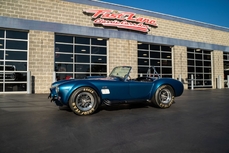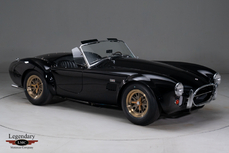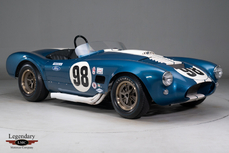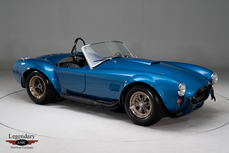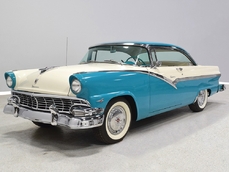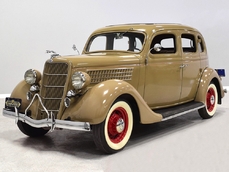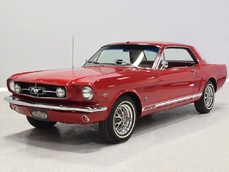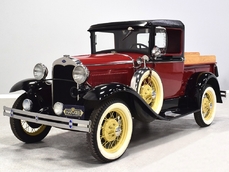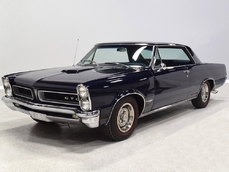Shelby Cobra 427 427 cubic inch V8 1965
Allmän beskrivning :
The Shelby Cobra is the most imitated car of all time. From the dozens (hundreds?) of replica manufacturers to the Dodge Viper, putting a big engine in a small roadster has been a major industry for decades. With real Cobras easily bringing $1 million or more on a routine basis, the replica market has exploded and they’ve become a thing unto themselves, built to suit each individual owner and capable of more performance and speed than any stock original Cobra could imagine.
But if you want the real experience, the feeling that guys had in 1964 when they drove their new Cobras off the dealer lots, there aren’t many choices. A replica Cobra isn’t necessarily an accurate Cobra. Which is where Peter Bayer and Contemporary Classic Motorcars comes in. One of the earliest Cobra replica builders, Contemporary set out to build an affordable alternative to the original, which even in the early 80s was seeing skyrocketing values. Peter Bayer, founder of Contemporary, owned Shelby Cobra CSX3045, a real-deal Cobra, and used that as the blueprint for his replicas. As a result, the Contemporary Cobras are arguably the most accurate replicas ever made, right down to the round tube frames and body molds pulled directly from CSX3045. Today, Contemporary Cobras have become collectors’ items in their own right, representing an uncompromising look at Shelby Cobra building and an authentic experience.
Which brings us to this beautifully built Contemporary Cobra, CCX-33111. This is not a homemade car, but a professionally built Cobra that was assembled and finished with an almost fanatical devotion to originality. It’s powered by a 1965 Ford 427 side-oiler, it has an NOS Toploader 4-speed, and even things like the carburetors and oil pan are NOS Ford parts for a real Cobra. The kit was purchased in 1985 from Russell’s All Custom Engineering in Pomona, California in 1985 by SAAC member Vince Marcy, who used all the Shelby Club’s resources to finish construction. It was completed in 1988 and driven about 1000 miles, but for reasons unknown, it was stored until 1999. Today it shows just 1244 miles, and that’s since it was completed, so it remains in exemplary condition. The fiberglass bodywork is smooth, clean, and devoid of cracks or other issues. The bright Candyapple Red paint with Wimbledon White stripes has a brilliant shine and no evidence that it is now nearly 35 years old. Finish quality is worlds better than you would expect of a replica, with excellent gaps and a huge amount of time invested in getting the panels as smooth as possible. There’s simply not a ripple or wave anywhere on the car and its gentle use and careful storage is reflected in every aspect of the car.
Accurate details abound, including the shape of the car itself. Up front, you’ll note a low-mounted oil cooler, a set of chrome bumperettes, and Lucas-style parking lights. The hood shows proper rivets holding the support brace and scoop in place. Racing-style mirror and wind wings are NOS pieces purchased from a Ford dealer. And, of course, no Cobra is complete without a flip-up gas cap. You will also find correct Cobra badges, a single chrome roll hoop, and unusual rectangular taillights that were unique to the SC cars.
Climbing into the cockpit is to travel in time back to 1965. The buckets are finished in black leather, not vinyl, for a correct look and feel and they really are quite comfortable. The shifter is a Mustang unit that’s flipped backwards for that unique forward-canted look, and the steering wheel, while perhaps a little thicker than 1965, looks quite convincing with its AC horn button (not Cobra) which suggests that details were very important to the builder. Smiths gauges are used in the dash, although they’re not quite exact replicas of the original reverse-rotation units but they’re quite attractive (reproduction reverse-rotation gauges are available today). Toggle switches handle the basics, there’s a pushbutton starter on the left, and nobody even thought about adding a radio or heater. For safety there are 5-point harnesses for both driver and passenger, as well as a fire extinguisher mounted to the forward edge of the transmission tunnel. The carpets, side panels with map pockets, and vinyl dashboard are all in excellent condition with zero signs of use or wear. Even the trunk is neatly finished with a set of matching carpets, along with the fuel pump and remote battery. There is no top, but if you’re using your Cobra correctly, you won’t need one.
The engine is a correct 1965 date-coded 427 cubic inch Ford V8, and it is a correct “side oiler” as used in the original Cobras. It was purchased from Ford Power Parts in Norwalk, California in 1984 and was more recently rebuilt in 2001 by Duffee Motorsports in Phoenix, Arizona. While they worked to keep the external look very much as it would have been in 1965, the internals have been upgraded with a full roller valvetrain, MSD ignition system (concealed in the original distributor) and pump-gas-friendly compression ratio. On top there are a pair of correct vintage 600 CFM Holley 4-barrel carburetors on a mid-rise tunnel ram intake, and they’re beautifully tuned so it starts quickly and idles well. Other correct details include NOS “pentroof” valve covers, a Ford expansion tank, and the round air cleaners on top of the carbs. A Ron Davis aluminum radiator is cooled by a massive electric fan with shroud, so it keeps its cool far better than the original setup. Build photos show twin pusher fans in place when it was completed, but since this car lived in California and Phoenix all its life, keeping it cool was critical. Today it runs ice cold and you should have no fears of running this Cobra at speed or sitting in traffic—it doesn’t care. A modern alternator, water pump, and upgraded plug wires help with reliability without notably compromising the original look.
Contemporary also insisted on an original-style round-tube chassis which few replica builders are using today. The front and rear suspension are Jaguar E-Type, which isn’t quite authentic but makes parts and tuning easy and the infinite adjustment of the Jaguar’s torsion bar front suspension is ideal for setting the car up for performance. Koni shocks all around help keep it buttoned down, yet it rides rather well thanks to Jaguar’s incomparable tuning. It sits low, as a Cobra should, but ride quality isn’t at all harsh. The transmission is an NOS Toploader 4-speed manual that was sourced from another Ford dealer, and you’ll note that even the oil pan is a correct NOS piece that was acquired at great expense from a vendor in Wisconsin (we have the receipt). Accuracy was extremely important here. The Jag’s rear end has 3.54 gears inside, so this Cobra is very street-friendly and the hugely powerful 427 doesn’t ever lack for acceleration in any gear. Jaguar brakes are powerful and easy to service, with the inboard rear discs providing a nice performance advantage. The exposed side pipes have racing mufflers built in, so it sounds like a Cobra but doesn’t make your ears bleed, and they’ve been ceramic coated satin black for a brutal, race-ready look. True knock-off Halibrand wheels are the only logical choice, and even the hubs are safety-wired in place. The tires are recent even though we feel they’re a little over-sized at 235/60/15 in front and 275/50/15 in back, but they don’t seem to present any issues.
Documentation is extensive, from build receipts to photos to Contemporary Classic Motorcars literature and parts lists to period advertising. This is one Cobra replica you can buy with confidence because every nut and bolt in it has a receipt attached and the details are exactly right.
The more we look at this car, the more impressed we are. It’s just gorgeous to look at and even though it takes a practiced eye to spot the small differences between the originals and most replicas, this one nails it. It looks predatory. The authentic parts give it the right feel and performance is electrifying.
http://www.harwoodmotors.com/vehicles/inventory_details.php?id=883
1965 Shelby Cobra 427 427 cubic inch V8 is listed såld on ClassicDigest in Macedonia by for $79900.
Fakta i bilen
Karosstyp : Personbil Märke : Shelby Modell : Cobra 427 Modellversion : 427 cubic inch V8 Motorvolym : 0.0 Årsmodell : 1965 Läge : Ohio
Såld
Information om säljaren
Såld
People who viewed this Shelby Cobra 427 also viewed similar Shelby listed at ClassicDigest
Other cars listed for sale by this dealer
om Shelby
Carroll Shelby, en legendarisk figur i bilvärlden, hade en anmärkningsvärd resa från att vara en framgångsrik racerbilsförare till att bli en känd sportbilstillverkare i USA. Hans berättelse är fylld med prestationer, innovationer och ikoniska bilar som satt outplånliga spår i branschen.Tidiga år och racingkarriär:
Carroll Shelby föddes 1923 i Texas. Han gjorde först en karriär som pilot under andra världskriget men fann sin sanna passion inom racing efter kriget. Shelby blev en framgångsrik racerbilsförare på 1950-talet och tävlade i olika evenemang inklusive Formel 1, uthållighetsracing och den berömda 24-timmars Le Mans.
Shelby Cobras - Ikoniska sportbilar:
Carroll Shelbys avgörande ögonblick som tillverkare kom med skapandet av Shelby Cobra, en ikonisk amerikansk sportbil. Cobra föddes från fusionen av ett brittiskt AC Ace-chassi och en Ford V8-motor, vilket skapade en lätt, högpresterande bil som dominerade banor och gator. Nyckelmodeller inkluderar:
Shelby Cobra 260 (1962): Den ursprungliga versionen med en 260 kubiktum (4,2L) V8-motor.
Shelby Cobra 289 (1963-1965): Senare iterationer med en 289 kubiktum (4,7L) V8-motor, inklusive tävlingsspecifika Cobras kända för sin racingskicklighet.
Shelby Cobra 427 (1965-1967): Den mest kraftfulla versionen med en 427 kubiktums (7,0L) V8-motor, känd för sin råa kraft och prestanda.
Ford Partnership - Shelby Mustangs:
Shelbys partnerskap med Ford ledde till skapandet av legendariska Shelby Mustangs. Den mest anmärkningsvärda modellen är:
Shelby GT350 (1965-1969): Baserad på Ford Mustang, modifierades GT350 av Shelby American, med förbättrad prestanda, hantering och distinkt stil.
Andra anmärkningsvärda modeller och prestationer:
Utöver Cobras och Mustangs hade Shelby flera andra viktiga bidrag:
Shelby Daytona Coupe: Skapad för att vinna mot Ferrari i internationella GT-racing, blev den här bilen den första amerikanska bilen att vinna FIA GT World Championship 1965.
Shelby Series 1: Introducerad i slutet av 1990-talet, detta var Shelbys moderna version av en högpresterande sportbil.
Ford GT40 spelar en central roll i Carroll Shelbys berättelse, särskilt i hans koppling till Ford och hans betydande bidrag till bilens framgång.
Ford GT40 utveckling:
Fords utmaning:
I början av 1960-talet försökte Henry Ford II förvärva Ferrari, men förhandlingarna föll isär. Detta sporrade Fords beslutsamhet att slå Ferrari vid det prestigefyllda uthållighetsloppet 24 Hours of Le Mans, som Ferrari hade dominerat i flera år.
Samarbete med Shelby:
Ford vände sig till Carroll Shelby och kände igen hans racingexpertis och meritlista. Shelby fick i uppdrag att leda GT40-projektet och förvandla det till en konkurrenskraftig racerbil som kan utmana Ferraris överhöghet.
Utveckling och triumf:
Under Shelbys ledning genomgick Ford GT40 en rigorös utveckling för att åtgärda initiala designfel och prestandaproblem. Flera iterationer producerades:
Tidiga försök: De första versionerna av GT40 fick problem med tillförlitlighet och hantering, vilket ledde till nedslående resultat på Le Mans 1964.
GT40 Mark II: Shelbys team gjorde avgörande förbättringar. Mark II, utrustad med en kraftfull V8-motor, förbättrad aerodynamik och förfinad ingenjörskonst, blev mycket konkurrenskraftig.
Le Mans seger:
1966 uppnådde Ford GT40 Mark II en historisk seger vid 24 Hours of Le Mans, med Shelby-coachade föraren Ken Miles som ledde loppet. Detta markerade den första vinsten för en amerikansk tillverkare på Le Mans, vilket bröt Ferraris dominans.
Fortsatt framgång:
GT40 fortsatte att dominera och vann Le Mans under de följande tre åren (1966-1969), vilket säkrade sin plats i racinghistorien och befäste Fords rykte som en kraft i internationell motorsport.
Shelbys bidrag till GT40-framgången:
Även om Carroll Shelby inte var direkt involverad i designen av GT40, var hans expertis inom racing och hans förmåga att sätta ihop och leda ett team av talangfulla ingenjörer, mekaniker och förare avgörande för att förfina bilens prestanda. Hans inflytande hjälpte till att ta itu med tekniska problem, förfina bilens hantering och lägga en strategi för tävlingstaktiken, vilket avsevärt bidrog till GT40:s framgångar på banan.
Arv och inverkan:
Ford GT40:s segrar i Le Mans under Shelbys ledning är fortfarande en av de mest ikoniska prestationerna i motorsportens historia. Bilens framgångar stärkte Shelbys rykte som en bilvisionär och stärkte ytterligare hans partnerskap med Ford.
Carroll Shelbys engagemang i GT40-projektet visade upp hans förmåga att förvandla ett kämpande projekt till en mästerskapsvinnande maskin, och lade ytterligare ett anmärkningsvärt kapitel till hans lysande karriär inom bilvärlden.



